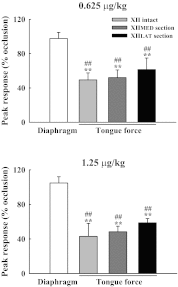Pulmonary C-fiber activation attenuates respiratory-related tongue movements
- PMID: 22936725
- PMCID: PMC3524667
- DOI: 10.1152/japplphysiol.00031.2012
Pulmonary C-fiber activation attenuates respiratory-related tongue movements
Abstract
The functional impact of pulmonary C-fiber activation on upper airway biomechanics has not been evaluated. Here, we tested the hypothesis that pulmonary C-fiber activation alters the respiratory-related control of tongue movements. The force produced by tongue movements was quantified in spontaneously breathing, anesthetized adult rats before and after stimulation of pulmonary C fibers via intrajugular delivery of capsaicin (0.625 and 1.25 μg/kg). Brief occlusion of the trachea was used to increase the respiratory drive to the tongue muscles, and hypoglossal (XII) nerve branches were selectively sectioned to denervate the protrusive and retrusive tongue musculature. Tracheal occlusion triggered inspiratory-related tongue retrusion in rats with XII nerves intact or following section of the medial XII nerve branch, which innervates the genioglossus muscle. Inspiratory-related tongue protrusion was only observed after section of the lateral XII branch, which innervates the primary tongue retrusor muscles. The tension produced by inspiratory-related tongue movement was significantly attenuated by capsaicin, but tongue movements remained retrusive, unless the medial XII branch was sectioned. Capsaicin also significantly delayed the onset of tongue movements such that tongue forces could not be detected until after onset of the inspiratory diaphragm activity. We conclude that altered neural drive to the tongue muscles following pulmonary C-fiber activation has a functionally significant effect on tongue movements. The diminished tongue force and delay in the onset of tongue movements following pulmonary C-fiber activation are potentially unfavorable for upper airway patency.
Figures






Similar articles
-
Neural drive to tongue protrudor and retractor muscles following pulmonary C-fiber activation.J Appl Physiol (1985). 2007 Jan;102(1):434-44. doi: 10.1152/japplphysiol.00982.2005. Epub 2006 Sep 14. J Appl Physiol (1985). 2007. PMID: 16973814
-
Effect of co-activation of tongue protrudor and retractor muscles on tongue movements and pharyngeal airflow mechanics in the rat.J Physiol. 1999 Sep 1;519 Pt 2(Pt 2):601-13. doi: 10.1111/j.1469-7793.1999.0601m.x. J Physiol. 1999. PMID: 10457075 Free PMC article.
-
Response of respiratory-related hypoglossal nerve activity to capsaicin-induced pulmonary C-fiber activation in rats.J Biomed Sci. 2003 Nov-Dec;10(6 Pt 2):706-17. doi: 10.1159/000073957. J Biomed Sci. 2003. PMID: 14631109
-
[The terminal hypoglossal nerve and its anatomical variability].HNO. 2019 Apr;67(4):242-250. doi: 10.1007/s00106-019-0632-8. HNO. 2019. PMID: 30874852 Review. German.
-
Neural control of tongue movement with respect to respiration and swallowing.Crit Rev Oral Biol Med. 2001;12(1):18-37. doi: 10.1177/10454411010120010101. Crit Rev Oral Biol Med. 2001. PMID: 11349959 Review.
Cited by
-
Does fetal growth restriction induce neuropathology within the developing brainstem?J Physiol. 2023 Nov;601(21):4667-4689. doi: 10.1113/JP284191. Epub 2023 Aug 17. J Physiol. 2023. PMID: 37589339 Free PMC article. Review.
-
Anatomic connections of the diaphragm: influence of respiration on the body system.J Multidiscip Healthc. 2013 Jul 25;6:281-91. doi: 10.2147/JMDH.S45443. Print 2013. J Multidiscip Healthc. 2013. PMID: 23940419 Free PMC article.
-
The Anatomical Relationships of the Tongue with the Body System.Cureus. 2018 Dec 5;10(12):e3695. doi: 10.7759/cureus.3695. Cureus. 2018. PMID: 30838167 Free PMC article. Review.
-
Obstructive Sleep Apnea and Role of the Diaphragm.Cureus. 2022 Sep 10;14(9):e29004. doi: 10.7759/cureus.29004. eCollection 2022 Sep. Cureus. 2022. PMID: 36159353 Free PMC article. Review.
References
-
- Adachi S, Lowe AA, Tsuchiya M, Ryan CF, Fleetham JA. Genioglossus muscle activity and inspiratory timing in obstructive sleep apnea. Am J Orthod Dentofacial Orthop 104: 138–145, 1993 - PubMed
-
- Bailey EF, Fregosi RF. Coordination of intrinsic and extrinsic tongue muscles during spontaneous breathing in the rat. J Appl Physiol 96: 440–449, 2004 - PubMed
-
- Bailey EF, Fregosi RF. Modulation of upper airway muscle activities by bronchopulmonary afferents. J Appl Physiol 101: 609–617, 2006 - PubMed
Publication types
MeSH terms
Substances
Grants and funding
LinkOut - more resources
Full Text Sources

